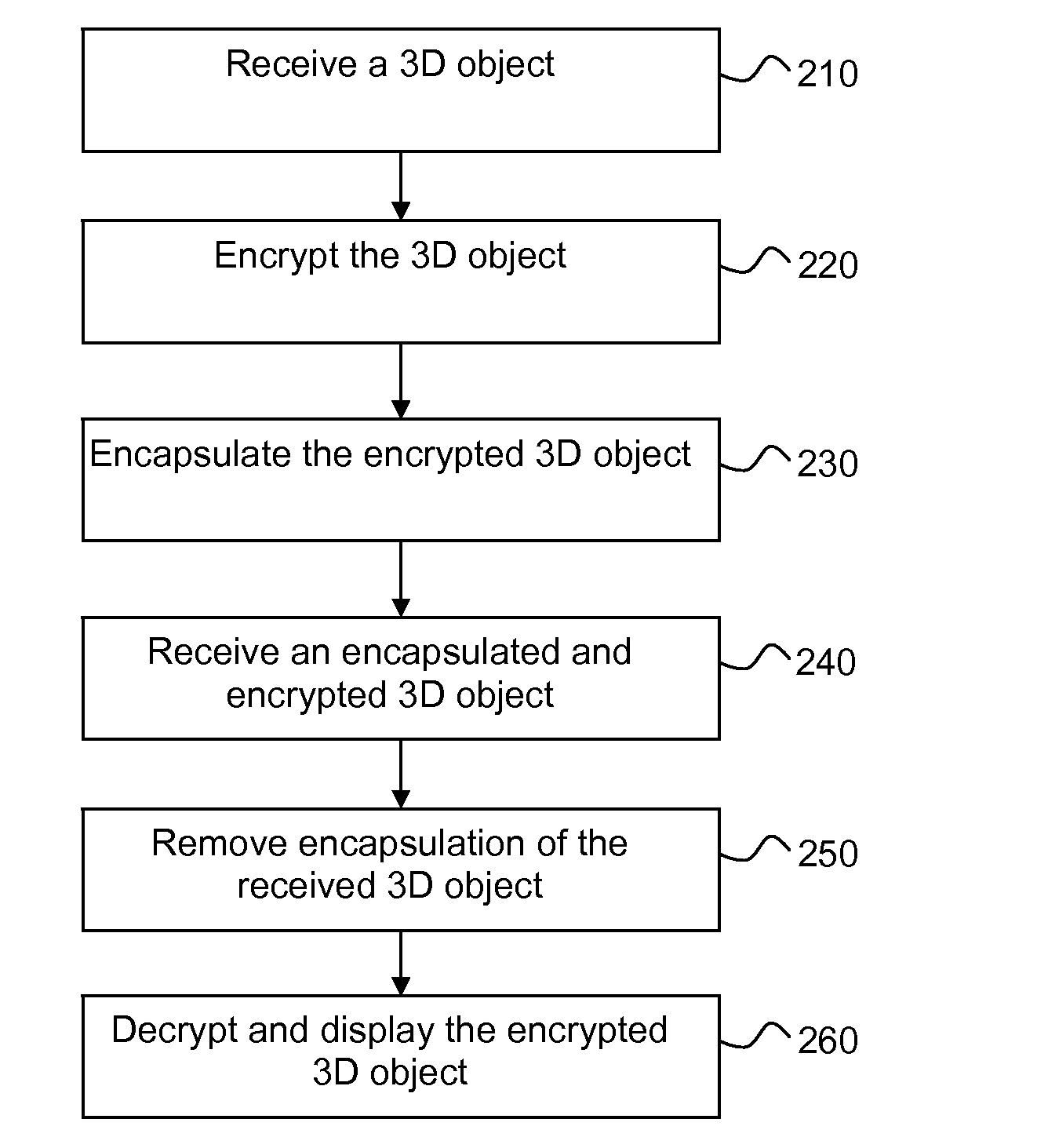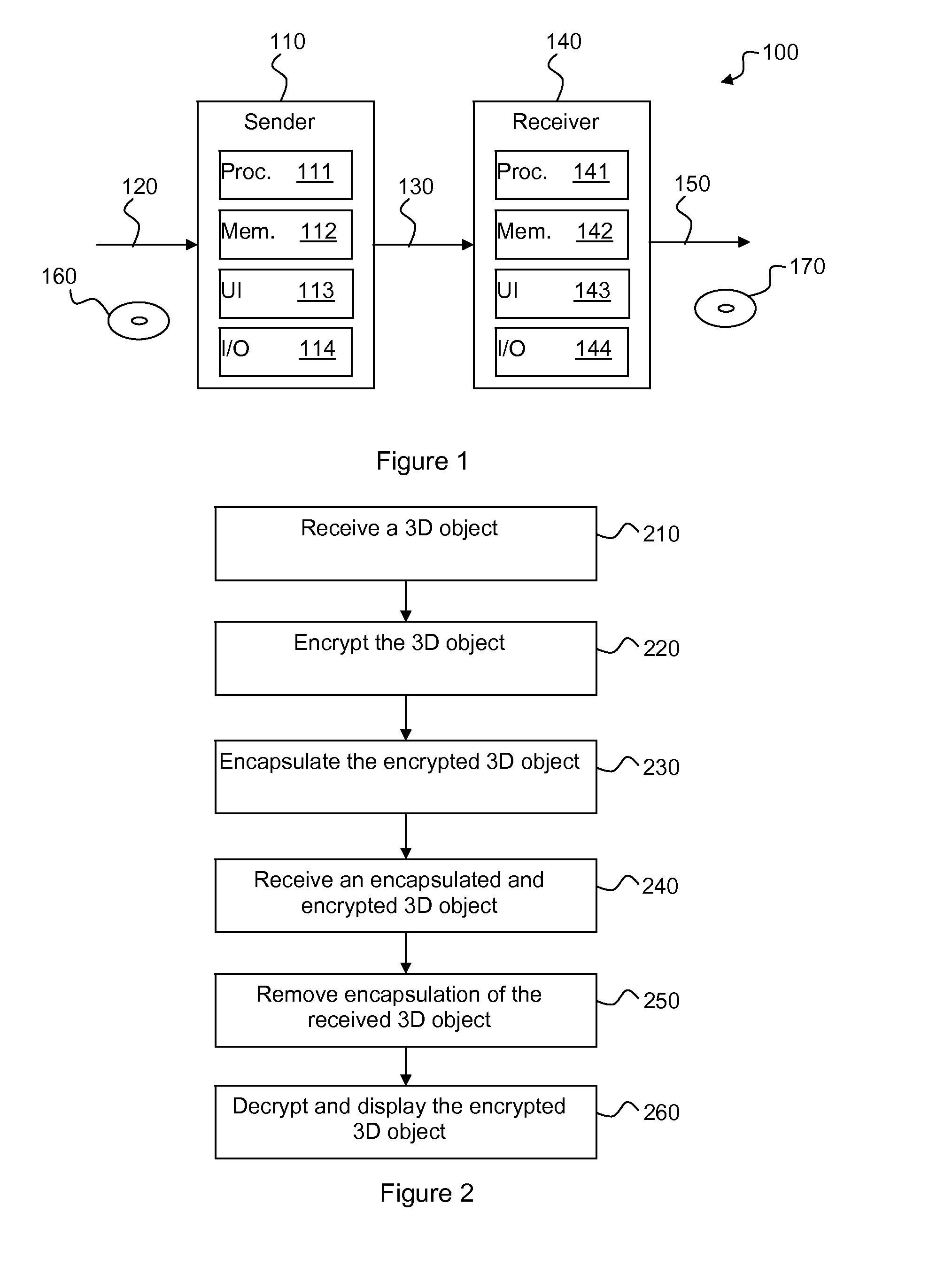Methods and devices for optimising rendering of an encrypted 3D graphical object
a technology of encrypted 3d objects and rendering methods, applied in the field of 3d models, can solve the problems of affecting the quality of the game, the difficulty of ensuring the integrity of the game,
- Summary
- Abstract
- Description
- Claims
- Application Information
AI Technical Summary
Benefits of technology
Problems solved by technology
Method used
Image
Examples
first preferred embodiment
Added Surfaces Defined by Existing Points
[0044]In a first preferred embodiment, a number s surfaces are added to the 3D object 120. These new surfaces are defined using the existing points. This may be illustrated as follows:
PointsSurfaces11. . .n points. . .m surfaces, indexes 1 . . . nnmm + 1. . .s surfaces, indexes 1 . . . nm + s
[0045]When providing the encapsulated object of the first preferred embodiment, it is necessary also to provide to the receiver the number s of added surfaces in order for the receiver to be able to remove the added surfaces during decapsulation. The number s may be sent using any suitable side channel, such as for example as metadata in the 3D object or in a specific field in a license linked to the 3D object.
second preferred embodiment
Added Surfaces Defined by Added Points
[0046]In a second preferred embodiment, a number s surfaces defined using a set of p added points are added to the protected object, as follows:
PointsSurfaces11. . .n points. . .m surfaces, indexes 1 . . . nnmn + 1m + 1. . .p points. . .s surfaces, indexesn + pn + 1 . . . n + pm + s
[0047]Naturally, it will be appreciated that it is possible to define some added surfaces using one or two initial points as long as at least one added point is used.
[0048]When providing the encapsulated object of the second preferred embodiment, it may also be necessary to provide to the receiver the number p of additional points to be able to retrieve the set of added surfaces. Indeed, the added surfaces are the only surfaces that use the added points (indices from n+1 to n+p). During decapsulation, the set of p points and the set of s surfaces are removed. As in the first preferred embodiment, any suitable side channel can be used to provide the value p. However, i...
third preferred embodiment
Using a Null Surface as a Tag
[0049]In the third preferred embodiment, s new surfaces defined using the existing points of the protected object are added and a “fake” surface, acting as a tag, is inserted to separate the original set of surfaces from the new surfaces. The fake surface is a null surface defined by the same point index for all its defining points (e.g. three for a triangle). In many cases, the receiver may easily detect this “fake” surface and thus extract the original surfaces.
[0050]However, some environments naturally produces this kind of null surfaces. In this variant, a new point is added so as to differentiate the added “fake” null surface from the natural null surfaces. This new point is added to the set of points of the encrypted object.
[0051]The resulting encapsulated object can be described as:
PointsSurfaces11n pointsm surfaces, indexes 1 . . . nnmn + 11 pointm + 11 surface: (n + 1, n + 1, n + 1)m + 2s surfaces, indexes 1 . . . nm + s + 1
[0052]When providing ...
PUM
 Login to View More
Login to View More Abstract
Description
Claims
Application Information
 Login to View More
Login to View More - R&D
- Intellectual Property
- Life Sciences
- Materials
- Tech Scout
- Unparalleled Data Quality
- Higher Quality Content
- 60% Fewer Hallucinations
Browse by: Latest US Patents, China's latest patents, Technical Efficacy Thesaurus, Application Domain, Technology Topic, Popular Technical Reports.
© 2025 PatSnap. All rights reserved.Legal|Privacy policy|Modern Slavery Act Transparency Statement|Sitemap|About US| Contact US: help@patsnap.com


